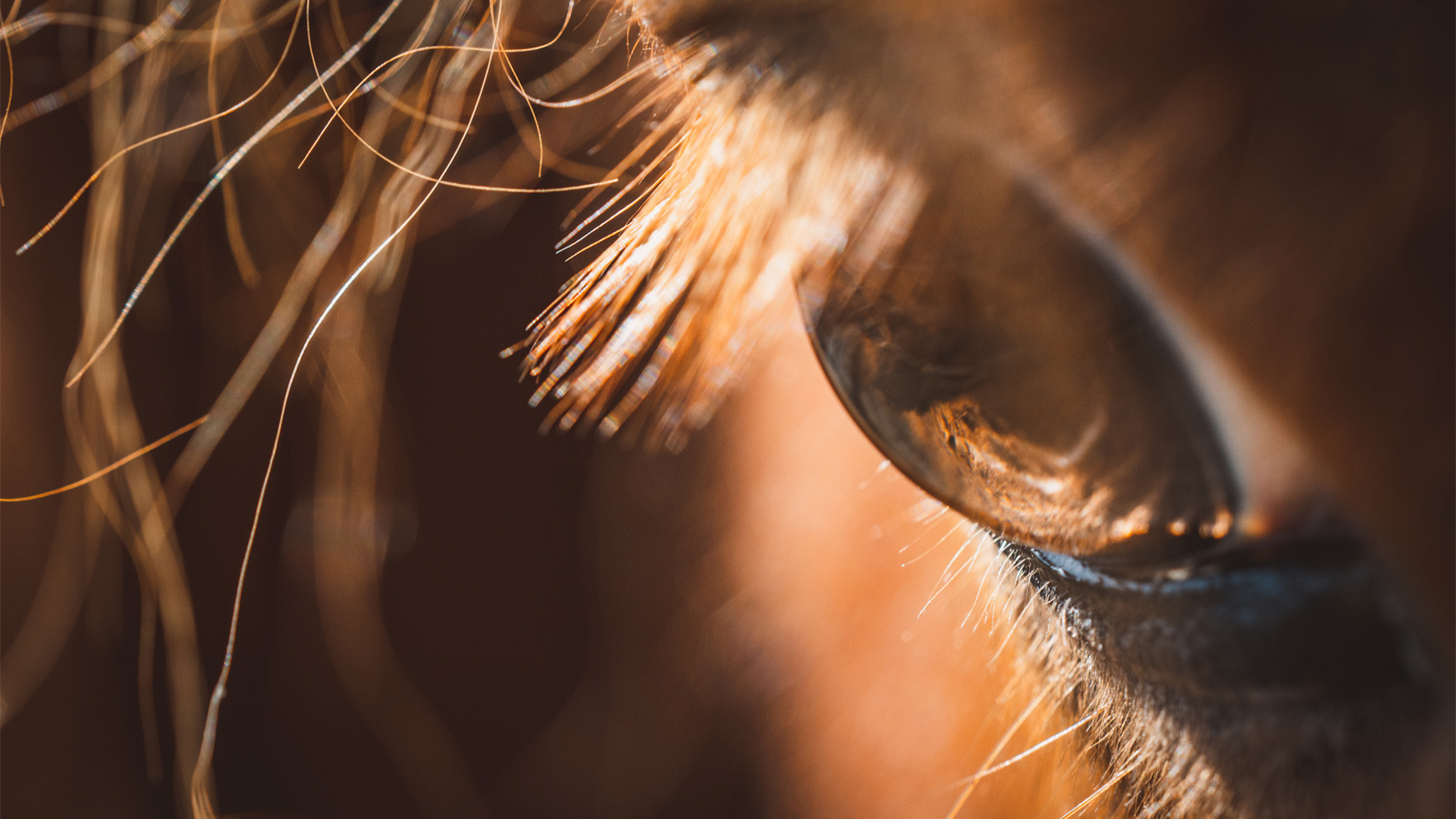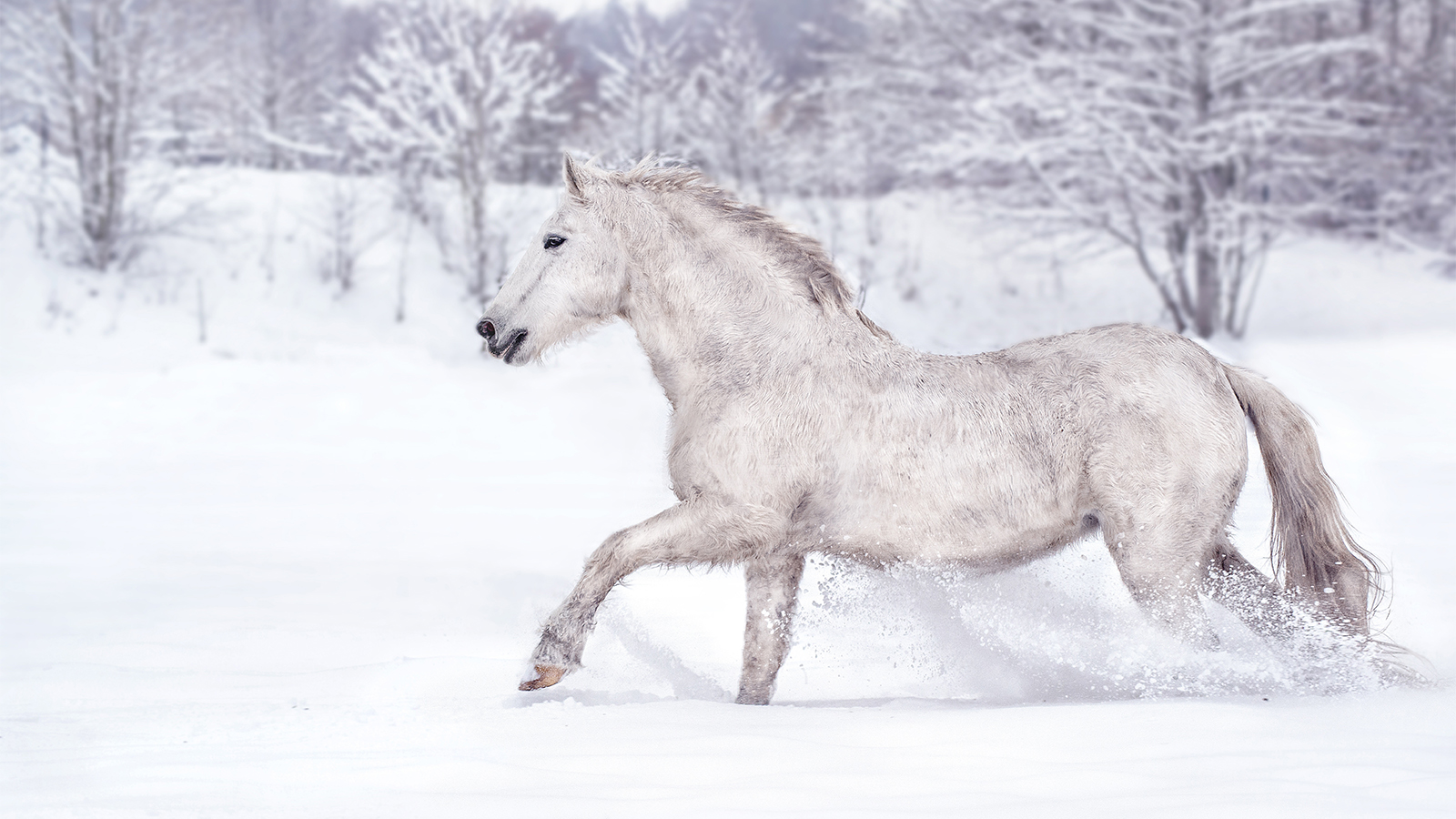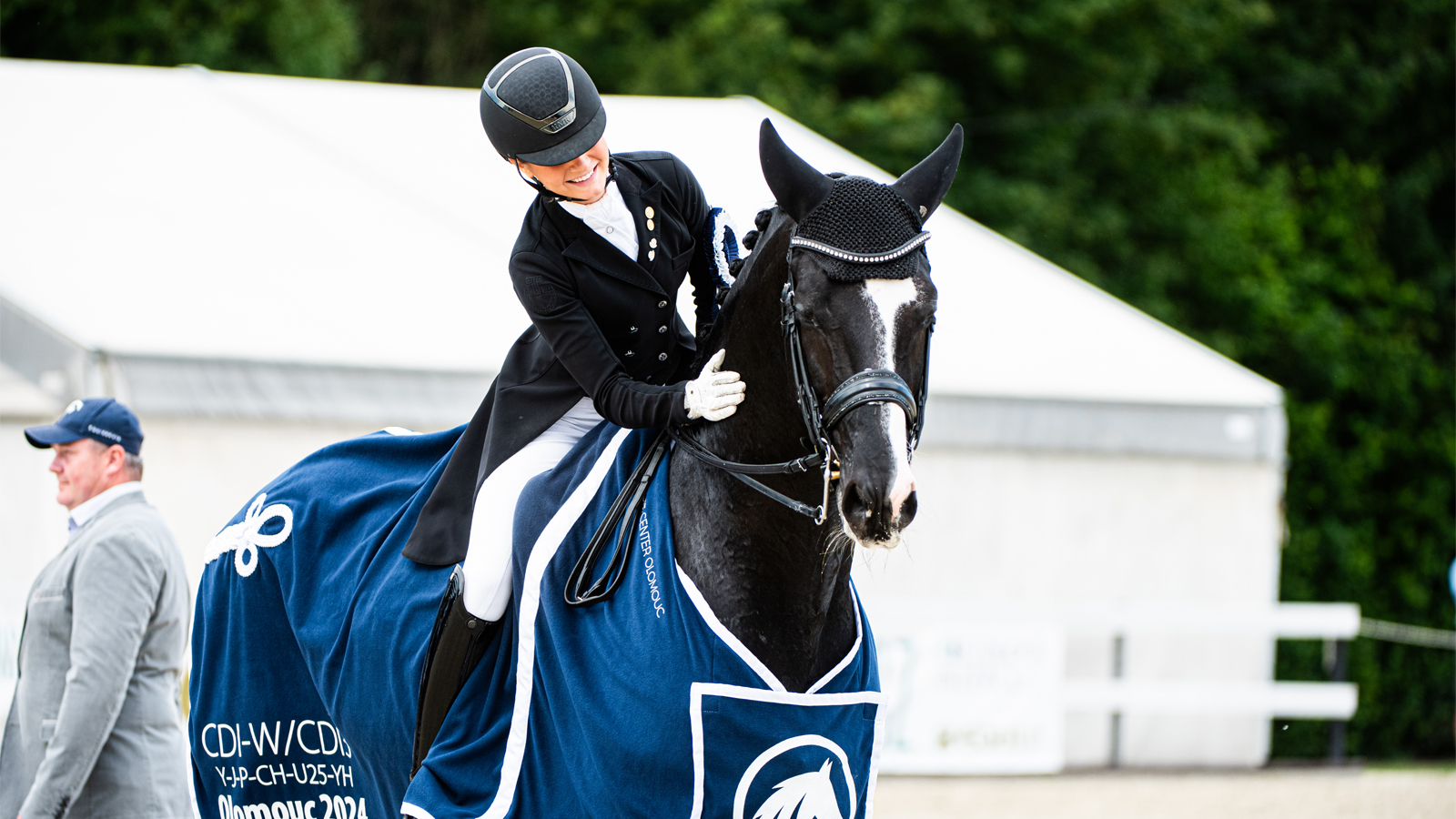Equine Recurrent Uveitis is an eye condition that has caused blindness in horses for centuries and sadly remains the major cause of blindness in horses today.
Whilst Equine Recurrent Uveitis (ERU) may start as a mild painful episode that improves with treatment, it continues to reoccur over time, each episode progressively more painful and of longer duration until, in some cases, the horse becomes nonresponsive to treatment and eventually blind.
Occasionally, an owner elects to remove the eye in a desperate attempt to relieve the pain for the horse, whilst in others total blindness necessitates euthanasia due to the difficulties involved in managing a blind large animal. Treatment measures have improved over the last few decades; however, there remains a lot more research to be done to improve management of these horses before irreversible damage is done.
ERU should not be confused with uveitis as this also occurs commonly in horses but doesn’t have the recurring episodes that are experienced with ERU. Often a case of uveitis can be treated and resolves completely. Uveitis in simple terms means an inflammation of the uvea. The uvea being the vascular, pigmented layer of the eye that lies between the retina and outer wall of the eye and extends to form the iris, ciliary body, and choroid structures in the eye.
Uveitis is often a secondary inflammation that occurs in the eye due to a primary injury such as an ulcer, keratitis, foreign body, or a blunt trauma to the eye and once the primary injury is rectified, the uveitis resolves completely. Uveitis can also occur in both eyes simultaneously due to a systemic illness, resolving once this systemic illness is treated. ERU is the repeated incidence of a primary uveitis in the eye, that despite treatment, flares up and is seldom completely cured. ERU has had several names and has previously been known as periodic ophthalmia or moon blindness.

Severe uveitis can result in blindness. Image by Dr Maxine Brain.
IMMUNE-MEDIATED
ERU is thought to be an immune-mediated disease, meaning the instigators of the inflammation are antigens within the horse’s own body. Certain large proteins within the structure of the eye’s retina contain epitopes (strongly antigenic portions of protein) and these induce a strong inflammatory response when they encounter cells from the immune system. In normal circumstances, these epitopes within the eye would not have direct contact with the immune system as there is a natural divide, the blood-ocular barrier, preventing direct association.
If, however, the barrier between the blood and the eye becomes disrupted, inflammatory cells and cytokines (proteins that effect the immune system) access the eye, triggering a cascade of events that lead to uveitis. In horses with ERU, it is believed these inflammatory cells (T-lymphocytes) remain within the eye and are responsible for relapses of uveitis over time, causing further tissue damage that exposes other epitomes to these inflammatory cells, helping perpetuate the disease.
ERU has also been associated with the bacterium leptospira, the organism responsible for the disease leptospirosis, but the exact reason behind this association has not been fully determined and may be as simple as the bacteria damaging the blood-ocular barrier and instigating the initial inflammatory event.
It should be noted, however, that not all horses that have an injury to the eye that upsets the blood-ocular barrier or have had leptospirosis end up with ERU, so there are other factors that are involved in establishing this disease. Studies have found that genetics can play a role in the susceptibility of some horses to ERU, with Appaloosas being up to eight times more susceptible to the disease. Additionally, if an Appaloosa develops ERU, it has a greater risk of becoming blind than other horses. This has been linked to a part of the chromosome (LP allele) that gives rise to the pigmented spots within the white colouring of the horse that is characteristic of many Appaloosas.
“It continues to reoccur
over time, each episode
progressively more painful.”

Appaloosas can be up to eight times more susceptible to the disease. Image by Josep Monter.
Icelandic Horses and some Warmbloods are also thought to have a genic predisposition to ERU, but the incriminating gene has not been clearly established. As ERU also occurs in many other breeds including draught breeds, Thoroughbreds, and Quarter Horses, further investigations into other contributing factors are needed.
CLINICAL SYNDROMES
There are three different clinical syndromes seen with ERU. The more common cases of ERU that I have seen in Australia follow the typical scenario of an inflamed painful eye that responds to anti-inflammatory medications initially, but over time progresses to recurrent bouts that respond less and less to medications until they require a continuous medication regime to control the disease.
The second is a low-grade uveitis that simmers along without the horse showing any painful symptoms until it has advanced damage occurring within the eye resulting in partial or complete blindness that then alerts the owner that there is a problem.
The third type of ERU involves the inflammation occurring in the chamber at the back of the eye (on the other side of the iris) and commonly causes degeneration to the retina and therefore blindness. The retina is the part of the eye that is responsible for capturing light, allowing vision to occur.
The clinical signs associated with the commonest form of ERU can be the same as for any other uveitis and include pain, redness, a constricted (small) pupil, corneal oedema, chemosis (swelling of the conjunctiva around the eye) and the deposition of cells, proteins, or fibrin in the eye. Pain is manifested as a closed or partially closed eye (blepharospasm), with tearing and an aversion to light entering the eye.

Mild constriction of the pupil is one of the indications of uveitis. Image by Dr Maxine Brain.
As most painful or injured eyes do present the same, (“closed with tearing”), it is important for the veterinarian to fully assess the horse and its eyes to look for a cause of the pain, as this will help differentiate uveitis caused by a trauma, injury to the eye, or a systemic illness from one of ERU.
As mentioned above, not all cases of ERU will present with a painful eye. In such cases, particularly in Appaloosas, the owner may only see slight changes in the eye such as a slight clouding; therefore, it is important for these horses to also be assessed by the veterinarian before there is irreparable damage occurs.
There are several other clinical observations that may only be detected by the veterinarian that will help differentiate ERU from other causes of uveitis. Signs of blood vessels growing deep with the cornea, irregularly shaped pupils and a darkened iris are highly suspicious of ERU. By testing the pressure within the eye (intra-ocular pressure) and comparing it to the “normal” eye, the vet can check for an acute uveitis in which the eye pressure drops, and the eye becomes “soft” versus a high pressure within the eye where the eye is hard and has a bulging appearance as is seen with chronic uveitis and ERU.
The vet can also use an ophthalmoscope to assess the back of the eye once the pupil is dilated and look for evidence of damage to the optic nerve and/or retina. Retinal degeneration, cataract formation, corneal mineralisation, synechiae, lens detachment and glaucoma can all be seen as long-term sequelae of ERU and any eye with these pathologies detected, should be assessed for a possible underlying ERU as the cause.
EARLY DIAGNOSIS
An early diagnosis of ERU will enable early treatment which can minimise further damage to the eye and therefore improve the horse’s chance of maintaining some reasonable vision into the future.
It is also extremely important that the veterinarian assessing a horse for a potential sale (pre-purchase examination) can recognise the subtle signs of ERU as this eye condition is a form of unsoundness, making the horse not fit for sale.
There are two desirable outcomes with treatment of ERU: the first is to resolve the pain and inflammation that is causing the horse so much discomfort; and the second is to reduce or prevent further episodes of ERU occurring. Anti-inflammatory medications such as corticosteroids and non-steroidal anti-inflammatory drugs (NSAID) are important for reducing the signs of inflammation and play an important part when the horse has an active uveitis. Phenylbutazone and finadyne (both NSAIDs) are commonly used systemically to reduce the pain in the eye, and cortisones, both topical and systemic, are powerful anti-inflammatories that can be used frequently during the acute stages of an ERU episode.
Topical atropine is also commonly used to help dilate the pupil during the active stages. ERU causes the muscles that control the pupil to go into a spasm, causing intense pain and pupil constriction, so by preventing and resolving the muscle spasms, the horse is much more comfortable. Atropine use for ERU is generally restricted to topical eye drops due to the side effects this medication can have if given systemically. Cyclosporin eye ointments have also been used for horses with ERU but as the cyclosporin does not penetrate through the cornea into the eye, their usefulness is limited.
As many of these eyes are very painful, trying to medicate them multiple times a day can be difficult, and in these horses special devices called “sub palpebral lavage tubes” can be used. These are placed into the conjunctiva around the eye and attached back through the skin and connected to a site such as the mane, allowing medication to be instilled through the tube, without having to directly touch the eyelids.
REDUCE THE RISK
To reduce the risk of recurrence of an ERU episode, NSAIDs and standard cortisone therapies are insufficient to rely upon, and although some veterinarians do prescribe daily cortisone drops to reduce the risk of recurrence, more specialised treatments are required. Several medications injected directly into the vitreous fluid within the eye have been shown to delay the onset of a relapse and these have included cortisones, macrolide antibiotics, aminoglycoside antibiotics and viral pieces containing a specific gene to prevent uveitis. Cortisones have also been injected into the back of the eye to prolong the anti-inflammatory response in the hope that a recurrence can be postponed.
To date, there has been no medication that has proven to be 100% effective at curing ERU and further studies into human uveitis may help with the discovery of more viable medical options.

The long-term outcome for horses suffering with ERU is not good but with early detection and quick intervention, the prognosis for affected horse can be improved.
Surgical treatments have also been tried but are not commonly available as their efficacy and rate of complication have not been fully evaluated, and they require specialised surgeons and equipment. One such treatment is the placement of a sustained-release implant containing cyclosporine into the sclera of the eye. Cyclosporin is an immune suppressant and therefore decreases the immune response that some white cells (T-lymphocytes) have to antigenic stimulation. This procedure has shown a lot of promise in preventing the recurrence of ERU flares but requires the implant to be replaced every 3-4 years to maintain its effectiveness.
“It also carries a
high complication rate…”
Another surgical procedure that has been used is called a Pars Plana Vitrectomy. In simple terms, the vitreous of the eye is removed and the fluid replaced with a type of saline solution in an endeavour to remove any inflammatory cells that reside within the eye and therefore prevent their continued reactivation of the inflammatory cascade within the eye. Whilst there have been very good results with this procedure, it also carries a high complication rate so may need further refinement before it is used more commonly as a treatment for ERU.
The long-term outcome for horses suffering with ERU is not good but with early detection and quick intervention, the prognosis for affected horse can be improved. And whilst not all the answers are known currently, there is hope that future research into this area could prevent many horses losing their eyesight, and their eyes unnecessarily. EQ
YOU MIGHT ALSO LIKE TO READ BY DR MAXINE BRAIN:
X-rays for Pre-Purchase – Equestrian Life, May 2024
Bandaging Tendons: Is It All Bad News? – Equestrian Life, April 2024
Diagnosing Respiratory Issues – Equestrian Life, March 2024
Anhidrosis: What Is Is? – Equestrian Life, January/February 2024
Fractured Jaws – Equestrian Life, December 2023
Keeping Our Country Free of Disease – Equestrian Life, November 2023
Managing Endometritis – Equestrian Life, October 2023
Granulosa Cell Tumours – Equestrian Life, September 2023
Being a Horse in Africa – Equestrian Life, August 2023
Splint Bone Fractures – Equestrian Life, July 2023
When Horses Choke – Equestrian Life, June 2023
The Challenge of Treating HPSD – Equestrian Life, May 2023
From the Horse’s Mouth: Salivary Glands – Equestrian Life, February 2023
Cardiac Murmurs – Equestrian Life, February 2023
Matters of the Heart – Equestrian Life, January 2023
Umbilical Concerns in Foals – Equestrian Life, December 2022
Retained Foetal Membranes – Equestrian Life, October 2022
Preparing for Laminitis – Equestrian Life, September 2022
Working Together for Best Outcomes – Equestrian Life, August 2022
What Constitutes an Emergency – Equestrian Life, July 2022
Peri-Tarsal Cellulitis Calls for Quick Action – Equestrian Life, June 2022
Sinusitis: Not To Be Sneezed At – Equestrian Life, May 2022
Japanese Encephalitis: No Cause For Alarm – Equestrian Life, April 2022
Hernia Learning Curve – Equestrian Life, March 2022
Osteochondromas: Benign But Irritating – Equestrian Life, February 2022
Don’t Forget the Water – Equestrian Life, January 2022
Don’t Forget the Water – Equestrian Life, January 2022
Understanding Anaesthesia – Equestrian Life, December 2021
A Quick Guide to Castration – Equestrian Life, November 2021
Caring for Mammary Glands – Equestrian Life, October 2021
Sepsis In Foals – Equestrian Life, September 2021
Understanding Tendon Sheath Inflammation – Equestrian Life, August 2021
The Mystery of Equine Shivers – Equestrian Life, July 2021
Heads up for the Big Chill – Equestrian Life, June 2021
The Ridden Horse Pain Ethogram – Equestrian Life, May 2021
The Benefits of Genetic Testing – Equestrian Life, April 2021
Heavy Metal Toxicities – Equestrian Life, March 2021
Euthanasia, the Toughest Decision – Equestrian Life, February 2021
How to Beat Heat Stress – Equestrian Life, January 2021
Medicinal Cannabis for Horses – Equestrian Life, December 2020
Foal Diarrhoea Part 2: Infectious Diarrhoea – Equestrian Life, November 2020
Foal Diarrhoea (Don’t Panic!) – Equestrian Life, October 2020
Urticaria Calls For Detective Work – Equestrian Life, September 2020
Winter’s Scourge, The Foot Abscess – Equestrian Life, August 2020
Core Strengthening & Balance Exercises – Equestrian Life, July 2020
The Principles of Rehabilitation – Equestrian Life, June 2020
When is Old, Too Old? – Equestrian Life, May 2020




